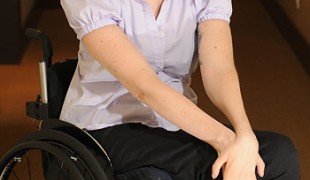- 5313
- 343
- 8
- 10
- 0
- Help Ukraine
About the solution
The ophthalmologist told Yoeri that he has to wear glasses all day but, moving in a wheelchair, Yoeri has problems wearing them because of knocking the glasses against the headrest of the wheelchair, and because he also has spasms.
So the students developed the Anti-tilt glasses: Spectacles designed so that the user can't bump their glasses into something. The glasses automatically reposition themselves after the bump so it's almost impossible that they get tilted.
The glasses consist of two parts: one that is placed along the ears and forehead, the other is a frame with lenses that is flexibly attached to the first part.
The first part is like a mask and is wore all against the head. The frame with the lenses is attached at a point to the first part. It absorbs the shock and then returns to its original position.
These glasses can be used by anyone that suffers from tilted glasses that they can't put right, whether in a wheelchair or not. It can also be used for sports.
The glasses can be made at home.
More info: http://www.instructables.com/id/Anti-tilt-glasses/
What about you, do you have any solutions? Please share them with the Patient Innovation community!
This solution shall not include mention to the use of drugs, chemicals or biologicals (including food); invasive devices; offensive, commercial or inherently dangerous content. This solution was not medically validated. Proceed with caution! If you have any doubts, please consult with a health professional.
DISCLAIMER: This story was written by someone who is not the author of the solution, therefore please be advised that, although it was written with the utmost respect for the innovation and the innovator, there can be some incorrect statements. If you find any errors please contact the patient Innovation team via info@patient-innovation.com
-
-
521
-
0
-
7462

Scooter for disabled people
MOVING IN A WHEELCHAIR: Moving using a wheelchair.
CAREGIVING
Amyotrophic Lateral Sclerosis
Assistive Daily Life Device (to help ADL)
Walking Aid (wheelchair/walker/crutches)
Gait abnormalities (e.g., walking difficulties, unsteady gait)
Muscle cramps or spasms
Difficulty coordinating movements
Stiffness or rigidity (difficulty moving)
Paralysis of the legs and lower body
Muscle weakness
Fatigue
Restoring mobility
Promoting self-management
Rehabilitating After Stroke
Managing Neurological Disorders
Promoting inclusivity and social integration
Preventing (Vaccination, Protection, Falls, Research/Mapping)
Caregiving Support
Neurology
Orthopedics
Rheumatology
United States
-
-
-
459
-
0
-
6631

Tetraplegic invents Portable bottle holder system
(SELF)-CARE: DRINKING: Drinking independently.
MOVING IN A WHEELCHAIR: Moving using a wheelchair.
Spinal Cord and Nerve Root Disorders
Cervical spinal cord injury/Tetraplegia
Walking Aid (wheelchair/walker/crutches)
Assistive Daily Life Device (to help ADL)
Difficulty coordinating movements
Stiffness or rigidity (difficulty moving)
Paralysis of the legs and lower body
Muscle weakness
Restoring mobility
Managing Neurological Disorders
Preventing (Vaccination, Protection, Falls, Research/Mapping)
Neurology
Belgium
-
-
-
397
-
0
-
5919

Tetraplegic creates clothing line for disabled people
(SELF)-CARE: DRESSING: Dressing independently.
MOVING IN A WHEELCHAIR: Moving using a wheelchair.
Spinal Cord and Nerve Root Disorders
Cervical spinal cord injury/Tetraplegia
Body-Worn solutions (Clothing, accessories, shoes, sensors...)
Walking Aid (wheelchair/walker/crutches)
Difficulty coordinating movements
Stiffness or rigidity (difficulty moving)
Paralysis of the legs and lower body
Muscle weakness
Promoting self-management
Managing Neurological Disorders
Promoting inclusivity and social integration
Neurology
Orthopedics
Canada
-
 en
en